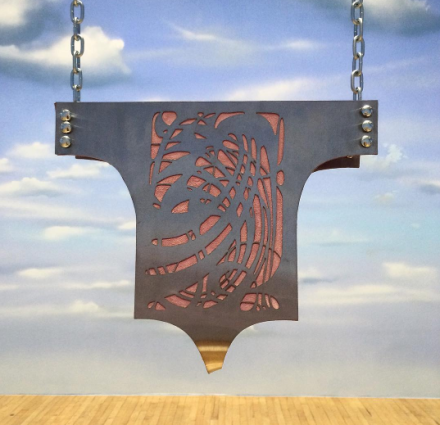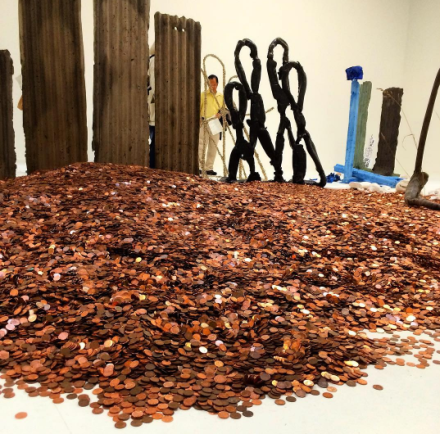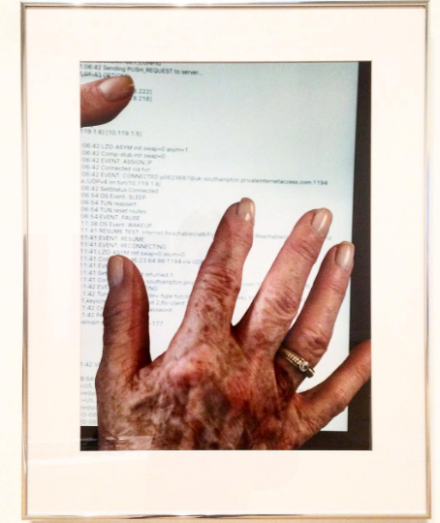
Anthea Hamilton, Project for a Door (After Gaetano Pesce) (2016), vi Art Observed
With the early weeks of the fall art season comes the opening of the annual Turner Prize exhibition, bringing together works from each of the artists’ nominated for Britain’s highest honor for contemporary art. This year’s exhibition, one of the more cohesively selected, and consistently inventive in recent years, has already earned impressive accolades, with a striking quartet of artist’s each exploring constructions of space and identity through diverse historical, technical, and material connections.

Anthea Hamilton, Guimard Chastity Belt (2016), via Art Observed
This year, many of the works seem to focus on the interconnected roles of history and identity in the creation of both contemporary objects, and some lost to history, perhaps best exemplified by Anthea Hamilton’s Project For A Door (After Gaetano Pesce), a massive sculpture of a man’s rear that was originally proposed for a Manhattan apartment development by the aforementioned designer. Pushing Pesce’s work engaging the human body as a design subject both in construction and use, Hamilton’s work here returns the question of identity to the current era, posing the massive buttocks against a series of swinging chastity belts, a counterpoint of sexual liberation that poses open-ended questions about gender imbalance and freedom in an era where these problems have taken center stage.

Michael Dean, United Kingdom poverty line for two adults and two children: twenty thousand four hundred and thirty six pounds sterling as published on 1st September 2016 (2016), via Art Observed
Following a somewhat similar thread of divergent times and spaces to vastly different results, Michael Dean’s work draws heavily on reclaimed materials and objects, twisting swaths of tubing and steel sheets into surreal landscapes spread across the gallery space, countered by a mass of pennies. Tallying £20,435.99, the pile falls a single cent short of poverty line, underscoring a distinctly material sense of poverty that feels all the more impactful when presented alongside his otherworldly spires of steel and plastic, as if creating a visual record of decay that keeps its financial underpinnings readily visible. Rather than dwell on social identity in its relationship with time (as in Hamilton’s pieces), Dean takes a more contemporary angle, presenting social concerns of the present in a relationship with materials relegated to a space outside of daily use.

Helen Marten, Brood and Bitter Pass (2016), via Art Observed
Helen Marten approaches objects from a similar perspective, harvesting “slippery and elusive” materials that can be quickly broken off from their day to day applications in the context of the gallery. Her sculptures, however, push beyond a mere appreciation of both their past and current contexts, entering into internally motivated sculptural relationships, or twisting themselves into the fabric of the gallery itself. In one piece, On Aerial Greens (Haymakers), the artist has created an arc of framed images, abstracted constellations of images spread over a rectangular hole in the wall, through which a cot made of reclaimed materials is placed. This interrogation of gallery space, incorporating conceptual critiques of the gallery form into a composition-first approach, allowing these threads of historical practice to open new explorations of the sculptural form.

A photo print by Josephine Pryde, via Art Observed
By contrast, Josephine Pryde’s investigation of the contemporary art object takes on a far more fatalistic approach. Exhibiting her work from the 2015 Venice Biennale, Pryde’s “Train to Nowhere,” is framed by a series of images that emphasize their own meaninglessness. Human hands hover over computer screens, or linger over human bodies, taking a long fascination of new media works with the body part as the point of engagement with the world around it, and the manipulator of digital systems around the globe. Countered by the often subdued atmosphere of her images, Pryde’s work goes much further in her critique and examination of this phenomenon than artists of similar interests, exploring the intersection of this vast and new human power against the seeming banality of its functions.
It’s the subtle intersection of themes and practices that join together these works, and the curatorial selections of the Turner Prize committee that make this year’s exhibition so impressively cohesive, tracing a wide path through modernity that manages to touch of many social and political threads with a minimal economy of objects and pieces. While the exhibition remains open for a public consideration before the final announcement, the show manages to present itself less as a summary of contestants than a real exploration of art in 2016, a feat that will surely make picking a final winner a difficult prospect.
The exhibition remains on view through January 2nd, 2017.
— D. Creahan
Read more:
Turner Prize Exhibition [Turner Prize Website]
A deeper look into the art world’s most controversial award: The Turner Prize [CNN]
Turner Prize 2016: Positive reviews for nominees [BBC]



